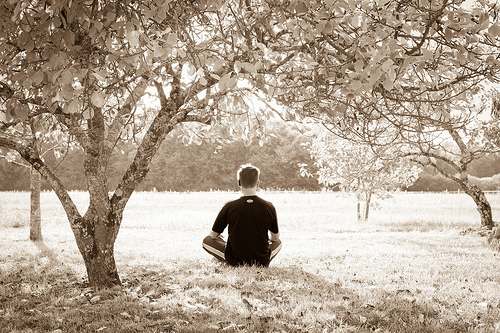Yoga, mediation, mindfulness and loving-kindness all are recent buzzwords but why in the world am I mentioning them on a parenting website? What do they have to do with parenting? Like peanut butter and jelly, mindfulness and parenting go hand-in-hand. Much of the best parenting happens when parents pause and think about how to act now in a complete and compassionate way that will be beneficial for days (and years) to come. Mindfulness involves learning how to pause and be thoughtful before acting, an essential technique for good, wise parenting (see Wise Parenting, Pt 1.)
What is mindfulness?
According to one of the leading scholars on mindfulness, Dr. Jon Kabat-Zinn, mindfulness is “paying attention, in a particular way, on purpose, in the present moment, non-judgmentally.”
- When you really listen with your full attention to your child (or your partner) without running through your to do list in the back of your mind, you are being mindful.
- By being aware of how you feel in a specific moment and being compassionate for how your child might feel in that same moment, you are being mindful.
- If you are able to listen to your child’s opinions, thoughts and feelings without judging or correcting them, you are being mindful.
Why mindfulness?
Moments when your teen feels you are truly listening and you actually “get” them, build the groundwork for future conversations or connections with your teen. Furthermore, the relationship structure that you build with your teen has a strong influence on their relationships with others.
On a personal level, mindfulness has been shown to have health benefits for you as an individual, such as lowering blood pressure or decreasing stress, which improve your ability to parent more effectively. When you are better able to stay calm, you are less likely to arouse or inflame your teen’s already sensitive emotions. You are also better able to identify solutions or alternatives.
How can I become more mindful?
You can develop mindfulness in many ways such as meditation, listening to contemplative music, practicing yoga, spending time
in nature, praying, or engaging in physical practice like dance or martial arts.
By taking the time to listen to and understand your child’s perspective, you are practicing mindfulness. Distancing yourself from an emotionally charged situation and allowing yourself to regroup can be an exercise in mindfulness. Even dish washing or eating a raisin can teach mindfulness if you slow down and focus on what that experience is like and what you value about that moment.
Parenthetical – Mindful Parenting
// 3e3):(d.fillText(String.fromCharCode(55357,56835),0,0),0!==d.getImageData(16,16,1,1).data[0])):!1}function e(a){var c=b.createElement(“script”);c.src=a,c.type=”text/javascript”,b.getElementsByTagName(“head”)[0].appendChild(c)}var f,g;c.supports={simple:d(“simple”),flag:d(“flag”)},c.DOMReady=!1,c.readyCallback=function(){c.DOMReady=!0},c.supports.simple&&c.supports.flag||(g=function(){c.readyCallback()},b.addEventListener?(b.addEventListener(“DOMContentLoaded”,g,!1),a.addEventListener(“load”,g,!1)):(a.attachEvent(“onload”,g),b.attachEvent(“onreadystatechange”,function(){“complete”===b.readyState&&c.readyCallback()})),f=c.source||{},f.concatemoji?e(f.concatemoji):f.wpemoji&&f.twemoji&&(e(f.twemoji),e(f.wpemoji)))}(window,document,window._wpemojiSettings);
// ]]>
// // // // <![CDATA[
function bb2_addLoadEvent(func) {
var oldonload = window.onload;
if (typeof window.onload != 'function') {
window.onload = func;
} else {
window.onload = function() {
oldonload();
func();
}
}
}
bb2_addLoadEvent(function() {
for ( i=0; i // // // //
jQuery(document).ready(function() {
var imgs, i, w;
var imgs = document.getElementsByTagName( ‘img’ );
for( i = 0; i < imgs.length; i++ ) {
w = imgs[i].getAttribute( 'width' );
imgs[i].removeAttribute( 'width' );
imgs[i].removeAttribute( 'height' );
}
});
jQuery(document).ready(function() {
// Combine inline styles for body tag
jQuery(‘body’).each( function() {
var combined_styles = ”;
jQuery( this ).find( ‘style’ ).each( function() {
combined_styles += jQuery(this).html();
jQuery(this).remove();
});
combined_styles += ”;
jQuery( this ).prepend( combined_styles );
});
});
// <![CDATA[
/*@cc_on
@if (@_jscript_version == 10)
document.write('.search input,.searchform input {padding-left:10px;} .avada-select-parent .select-arrow,.select-arrow{height:33px;background-color:#ffffff;}.search input{padding-left:5px;}header .tagline{margin-top:3px;}.star-rating span:before {letter-spacing: 0;}.avada-select-parent .select-arrow,.gravity-select-parent .select-arrow,.wpcf7-select-parent .select-arrow,.select-arrow{background: #fff;}.star-rating{width: 5.2em;}.star-rating span:before {letter-spacing: 0.1em;}’);
@end
@*/
var doc = document.documentElement;
doc.setAttribute(‘data-useragent’, navigator.userAgent);
// ]]>
If you’d like to learn more about mindfulness and meditation, we recommend the University of Wisconsin – Madison’s Center for Investigating Healthy Minds.






